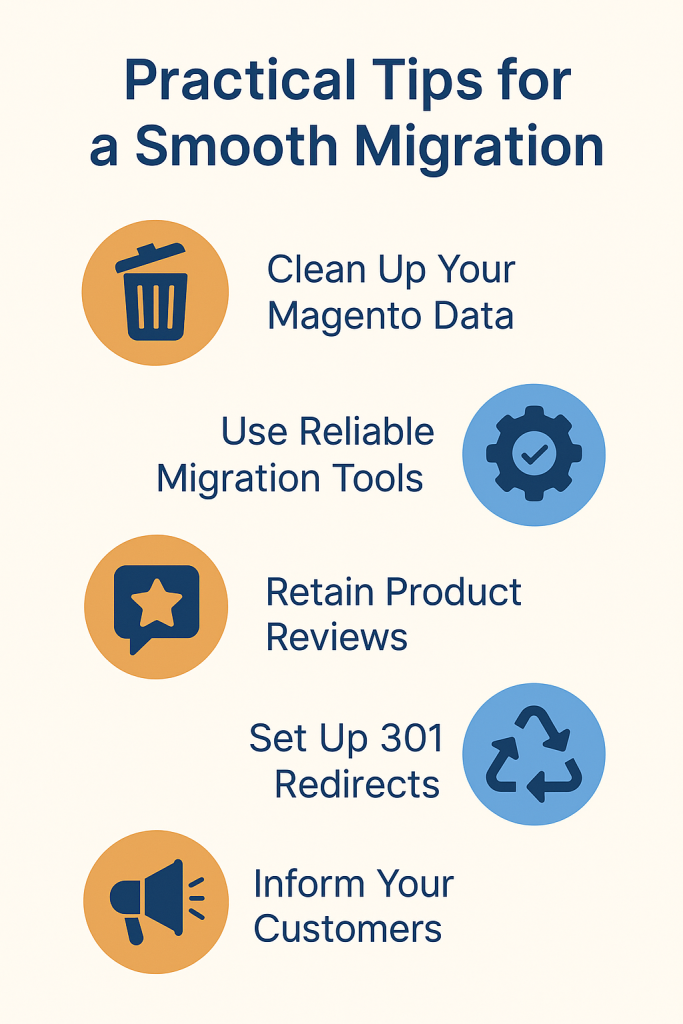You’re not alone if you’re running your online store on Magento and finding it increasingly complex, expensive, or challenging to manage. Thousands of eCommerce merchants are switching to Shopify, a platform known for its simplicity, flexibility, and ease of use. This shift is driven by the growing need for a scalable solution that doesn’t require a full-time development team to maintain.
But switching platforms isn’t just about changing the look of your store. A proper Magento to Shopify migration involves transferring all your crucial store data, including products, customers, order history, SEO URLs, and more, without losing functionality, SEO rankings, or customer trust. That’s where professional Magento migration services become essential.
In this blog, we’ll guide you through the entire migration journey from why you should consider moving from Magento to Shopify to how Magento to Shopify product migration works, and the services available to support a seamless transition.
Also Read: Migrate BigCommerce to Shopify
Why Are Merchants Moving from Magento to Shopify?
Magento has long been favored for its customizability and control. But with that power comes complexity. Running a Magento store often means managing hosting, hiring developers for every minor update, and keeping up with security patches, which can drain your time and budget.
On the flip side, Shopify offers a cloud-based, all-in-one platform that lets store owners focus more on growing their business than fixing technical glitches. It’s intuitive, comes with a rich ecosystem of apps, and scales easily with your business.
As more businesses seek simplicity and reliability, Magento to Shopify migration services are becoming a popular solution to overcome Magento’s limitations.
What’s Involved in Magento Data & Product Migration?
Migrating your store isn’t just about moving products. A proper Magento data migration strategy includes transferring every key aspect of your store to Shopify, from product images and variants to customer records, order history, SEO metadata, and more.
Common Data Points to Migrate:
| Data Type | Details Transferred |
| Products | Titles, descriptions, SKUs, prices, inventory, images, and tags |
| Product Variants | Sizes, colors, custom options |
| Categories | Nested category structure and navigation |
| Customers | Emails, names, addresses, account status |
| Orders | Purchase history, order status, payment method (masked) |
| Reviews | Product ratings and customer feedback |
| Content Pages | About Us, FAQs, Contact Page, and other CMS pages |
| Discount Codes | Promo code logic, usage limits, and expiry dates |
| SEO URLs & Redirects | 301 redirects from old Magento URLs to Shopify URLs |
Migrating this data properly ensures you maintain the integrity of your business while providing a consistent experience for returning customers.
Magento to Shopify Migration Process
While every store is unique, most migrations follow a structured process. Whether you’re working with a service provider or using a tool, here’s what the migration roadmap typically looks like:
1. Preparation & Planning
Start by auditing your Magento store. Identify which data you want to migrate and clean up outdated or irrelevant information. It’s also wise to fully back up your site before making any changes. This phase includes setting up your Shopify store, choosing a theme, setting up collections, and installing core apps.
2. Data Export from Magento
Using built-in tools or extensions, export your products, customers, and order history from Magento. If you’re using automated tools like Cart2Cart or LitExtension, this process becomes much easier, as these platforms streamline the data extraction step.
3. Data Import to Shopify
This is where the Magento to Shopify product migration becomes technical. The goal is to accurately map data fields from Magento to Shopify’s data structure. Ensure your product variants, categories, and tags match Shopify’s system correctly. Shopify’s import features and migration apps help facilitate this, but complex migrations may require expert intervention.
4. Design & Theme Replication
Shopify themes are different from Magento templates. To retain your branding, you must either customize a Shopify theme or develop one from scratch to match your Magento store’s look and feel.
5. Testing and Quality Checks
Before going live, thoroughly test your store. Ensure products display correctly, collections are appropriately structured, and the checkout process is smooth. Also, test redirects from your old Magento URLs to Shopify to prevent SEO loss.
6. Launch and Post-Migration Support
Once your new store is ready, it’s time to go live. After launch, monitor analytics and test performance, and address any issues. Update your sitemap and submit it to Google Search Console to help search engines recognize your new URLs.
Magento to Shopify Migration Services
Hiring a professional migration service can save work hours and prevent costly errors. Whether you’re migrating 100 products or 10,000, the right partner can make a big difference.
Key Features of a Good Magento Migration Service:
- Deep understanding of both Magento and Shopify architectures
- Ability to preserve SEO structure and set up 301 redirects
- Complete data migration including customers, orders, and custom fields
- Post-launch support for bug fixing and performance optimization
- Option to replicate your store’s branding or offer custom design
These services are ideal for store owners who want peace of mind and a fast, effective migration without handling the technical complexities themselves.
Practical Tips for a Smooth Migration
Moving your store doesn’t have to be overwhelming. Here are some actionable tips that ensure a clean, safe, and successful switch from Magento to Shopify:

- Clean up your Magento data before exporting. Remove duplicate SKUs, expired coupon codes, and inactive products.
- Use reliable migration tools like LitExtension or Matrixify if you’re not hiring a full-service agency.
- Retain product reviews using apps like Judge.me or Loox,social proof boosts conversions.
- Set up 301 redirects from old Magento URLs to your new Shopify pages. This is essential to avoid losing search engine rankings.
- Inform your customers about the update via email, and offer a small incentive to revisit your new Shopify store.
Magento vs Shopify: What’s the Difference?
Here’s a quick comparison to help you understand why so many brands are switching:
| Feature | Magento | Shopify |
| Hosting | Self-hosted | Fully hosted |
| Ease of Use | Developer-dependent | User-friendly |
| App Ecosystem | Less intuitive, more technical | Extensive app marketplace |
| Security | You handle updates and patches | Shopify handles security and compliance |
| Total Cost of Ownership | High (hosting + dev costs) | Predictable monthly fee |
| Design & Themes | Highly customizable but complex | Easy to customize with drag-and-drop |
If your business is ready to scale and you want a platform that grows with you without the technical overhead, Shopify is a solid long-term solution.
Final Thoughts: Make the Migration Work for You
Switching from Magento to Shopify can be a game-changing decision for your eCommerce business. But it’s not just about moving data, it’s about making a smart transition that keeps your store running smoothly, preserves your SEO rankings, and improves the overall shopping experience for your customers.
Whether you handle it in-house, use migration tools, or hire a professional Magento to Shopify migration service, the goal is a fully functional, optimized, and scalable online store on Shopify.



